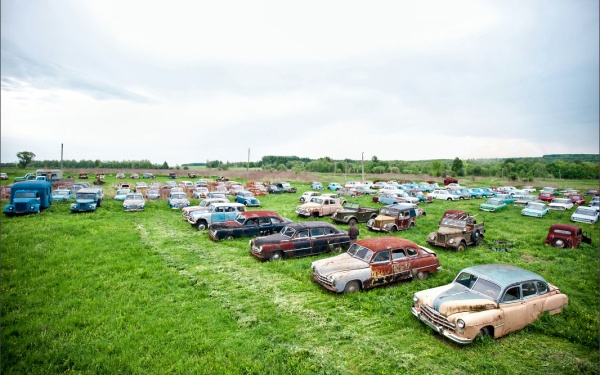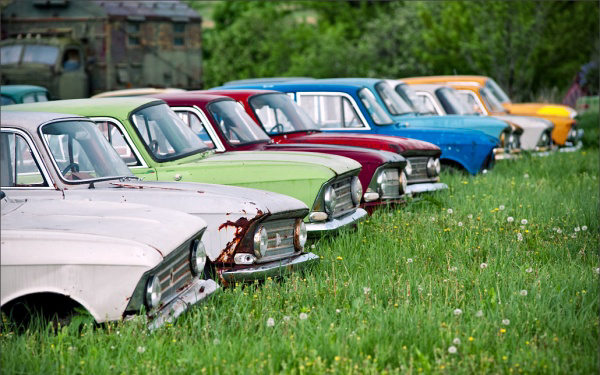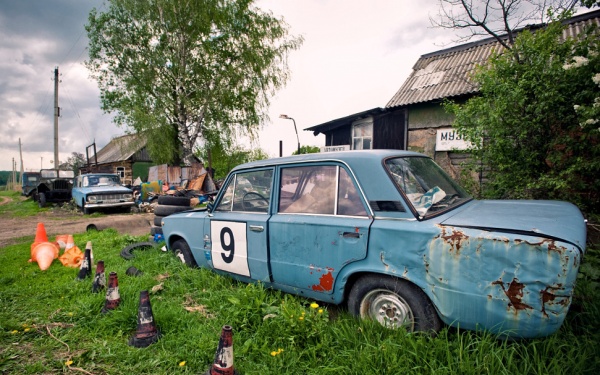
During the Cold War era we didn’t see or hear much about the Russian automotive industry. It was a strange time for the Soviets, as they were torn between communistic ideals and a rising desire for personal transportation. Even with this demand, it took a number of years before they produced cars for the masses and it wasn’t until the fall of the USSR that they imported cars on a large scale. They did export a few cars, but never to the States, so many of the cars in this field are relatively unknown to us. Reader Brandon F came across this Russian field find and seeing as he had never seen or heard of many of these cars as well, he thought we might be interested in having a look. Even if you aren’t a fan of socialist steel, it’s still an intriguing sight.

During the ’60s, ’70s, and ’80s, the Russian automotive industry tried it’s hardest to keep up with the Western world’s automotive technologies and design. At several points in time they turned to Western companies for help developing their industry. Ford, Fiat, and Renault have all played a role in helping get the Russian’s rolling. As a result of these ties, many of their cars were modeled after American, British, French and Italian cars. They usually tried to add their own sense of minimalism or drabness to the design, but a few made it to the street as almost identical copies of their Western counterparts.

From the stories we have been told and read, we assumed brightly colored cars would have been frowned upon by the Soviets. We are glad to see this assumption was off base, as there are a number of brightly colored cars parked in this field, granted the color pallet seems limited to just a handful of choices.

When we think of cars built for the masses, the last thing we think of are race cars. While the USSR automotive industry never built a sports car, that didn’t stop people from using their Ladas for high speed excursions. A few Russian built cars even competed in some major World Rally competitions. There appear to be several cars in this collection that may have seen some type of racing action.

We have to admit that we don’t know much about these Russian cars, but studying about them was definitely interesting. It’s been a great reminder that no matter our political, religious, or ideological beliefs our love for automobiles can bring us all together. It was also amazing to see the role automobiles have played in shaping the world we live in. More photos of this find can be found here at EnglishRussia. If you know more about any of these cars or can identify their make and model, please feel free to share!






This reminds me of the Top Gear (British of course) episode where they tested multiple Soviet cars. An interesting and unique find to be sure.
I am fascinated by the Russian automobile industry, and enjoyed the photos very much. Is this field in the former Soviet Union or here in the states?
However, I disagree with the perception that the Russian automotive industry was virtually nonexistant and relied heavily upon American designs to develop their industry.
The Russian Moskvitch was available since approximately 1930, and was a very successful offering. UAZ was available from about 1941 and ZAZ (which was later modeled after the American Lincoln, and to some extent, the Cadillac) produced upscale luxury vehicles for government officials from the 1960’s as well. Actualy ZAZ was originally founded in 1923! There were also ZIL (founded in 1916!)
The Lada and other Soviet cars became popular in the mid 1960’s and were designed after the Italian Fiat designs. I believe that they also drew heavily from the Czech Skoda and other Eastern Block designs, which would have been more readily available to them than the American examples.
There were a number of Russian microcar designs as well including the SMZ, ZMA, Zaporozhets (designed after the German Goggomobil and Polish Mikrus) and the Belke (which translates into Squirrel). There were also many military trucks and other military vehicles produced long before the 1950’s.
Finally, Russia has had a strong motorcycle industry including many military sidecar designs offered from Dnepr(offered as early as 1946, and named after the Russian river) and the IMZ-Ural (named after the Russian Mountain range), which hit the market in 1941 and both of which were copies of the German BMW designs.
Thanks for the info Charles! This field is actually in the Tula Region of Russia, which is directly south of Moscow. These are some great photos. I just wish there were some Russo-Balt era cars here, but they didn’t build many of those, especially after the October Revolution. Up until 1929, they didn’t have any large scale production facilities. That’s when they established GAZ and paid Ford to help them build their first factory in Nizhny Novgorod, which went on to build rebadged Model As.
ZAZ built the Zaporozhets (ZAZ 965, 966 and 968), not the luxury cars. Those were built by ZIL (AKA ZIS during Stalin’s time). They were actually copies of Packards at first since Stalin loved Pakcards. Later on they copied Lincoln and Cadillac designs.
To what extent did they copy them? Were they just visual copies or did they copy them at a technical level as well. I’ve read stories that they copied a few Studebakers from the Lend Lease program that they got their hands on, but haven’t had much success finding out whether they actually copied the entire design or just modeled theirs after them.
Roosevelt gave Stalin a Packard and I believe it was that car which was later copied as the ZIS 110/115. According to Wikipedia, it was reverse engineered from a 1942 Packard, so it might be that car. The later 1959-1981 GAZ M13 Chaika (Seagull) was also a stylistic copy of a Packard, I believe this time it was a 1955 model though.
I am not certain how much of a mechanical copy these cars were though. I know the Soviets copied the B-29 but used Soviet engines. Also, when Tupolev copied it, he had a problem since Soviet machine tools and sheet metal were all in metric units and the B-29 was SAE! Eventually he succeeded and the Tupolev TU-4 was born. The Soviets also built the DC-3/C-47 under license too (pre- Cold War a lot of American companies worked with the Soviets) where it was called the Li-2.
Packard/Zis Similarities:
As part of the Lend-Lease agreement, Packard did NOT send the Soviets all the tooling to build the ZIS, it’s a myth! The tooling was scrapped for the war effort.
I have been lucky to examine both versions in great detail. The Zil 110 is a SIMILAR copy of the Packard 180 limo. No body panels interchange, or even come close. The windshield is slanted back about 15 degrees more, and the entire rear of the car, roofline to bumper, looks more like the Pre-war Cadillac limo.
When it comes to the smaller pieces & bits, Here is what I discovered: The instruments are actual Stewart-Warner gauges, with Russian faces painted on. The Heater is from Packard, and the hardware on these heaters is SAE. The Radio (looking up from the floor as it was in the dash) is EXACTLY the same as the Packard Phillips radio. All the dash electrical items look to be USA made too.
Mechanical parts: The engine is a direct copy of the Packard 356. But with modifications. The ZIS has a special adapter on the oil pump that allows the pressure to be externally regulated for extreme cold weather. All the motor hardware is metric. The manifolds are clearly Packard parts, the casting # in the exhaust manifold has been ground down. The post war Packard, made at the same time as the ZIS, had vacuum wipers, the Zis has electric wipers. But the intake manifold has the vac port (to the vac pump on the mechanical fuel pump of the Packard), plugged with a SAE threaded plug, because it was not needed on the ZIS.
I examined a fully armored version of the ZIS 110 back in 1996. It had unusual 3″ thick glass, and all the windows opened! Even the small vent windows on the front doors opened, albeit only about an inch. Opening the driver’s vent window caused the glass edge to rub against the steering wheel after opening only a slight amount!
I started laughing hysterically when I discovered how the door glass was raised & lowered. If one wanted to lower the glass, there was a small chromed butterfly knob down near the base of the door, in the middle. (Rear seat passengers would have to bend down to the floorTurning the knob counter clockwise opened the hydraulic valve, allowing the glass to drop. Turning the valve clockwise stopped the glass decent. But that’s not what sent me into hysterical laughter, it was how the window was raised: A small chrome handle jutting out of a horizontal hole in the door panel, is raised & lowered, with each move downward, the window was raised about 1/4 inch. Yes folks, it was a small hydraulic bottle jack, the type used to change a tire!
I still have the image in my brain of a Soviet official in the limo, furiously jerking the little lever up & down, over & over again, as an attacker rushed at him, the glass slowly raising with each stroke!!!
And knowing people would never believe me, I did take pictures!
I briefly owned a Gaz 13 (Chaika) a 7 passenger sedan used for mid level aparatchiks, then on the secondary market as taxicabs. Built from 1958 to 1975, this is a design combo reminiscent of 55 Packard front, 57 ford sides, and 55 Buick rear. I took a good look at the power window switches, and they seemed to be Packard V8 parts (55-57), so I took one off the door, sure enough it had the casting part # on the back, the same as the Packard. I figured they simply bought what was left of the inventory from Studebaker-Packard after they stopped using them. No wonder Packard people like me couldn’t find original stock parts at the S-P parts facility in South Bend! And I’m pretty damn sure the heater box on the firewall is the same as 60’s Mopar cars.
I’ve never given it much thought, but does much popularity exist in Russia for restoring and maintaining antique cars? Are parts readily available for some models? Is there a ’64-’66 Mustang in the Russian car community? Are the 1950-60s even looked on with nostalgia as it is in the US and much of Europe? Also, I wonder how common it is to find a stash of old cars in Russia? I would think most old cars there were gathered up for recycling by the government many years ago, but this is just an assumption. 9
I heard growing up that cars were assigned to citizen by the government based on status and need and that waiting list were so long that it might take decades to get a car and it might have to last a lifetime but I’m not too sure how credible this was either…
Intriguing to say the least.
To help people who know nothing of Soviet vehicles (calling them all Russian is an insult to those who built them in other republics), I’ll identify some of them and give some history.
In the foreground of the first picture, the two tone car is a GAZ M12, as are the next three in line. Next to that appears to be a rare 4 wheel drive Moskvitch, which was probably based upon GAZ 69 mechanicals (as was the 4 wheel drive variant of the GAZ M20) In the second row back you see 3 GAZ 69 military vehicles. Also in that row is a beige GAZ M20 Poebda (victory), a design that came out in 1946 to celebrate the Soviet Union’s victory in The Great Patriotic War.
The next picture features the AZLK Moskvitch 400. If it looks like an early Opel Kadett K38 that’s because it is. The Soviet Union took the entire production line for the Kadett as a war prize and then modified it for suitability to Soviet road conditions. One of the main modifications was to switch it to a 4 door as the original German car was only sold as a 2 door.
The next picture shows a line of Moskvitch 408s. These were also exported to Western countries such as the UK as a means to raise hard capital.
In the foreground of the next picture is a blue VAZ Lada 2101. It was based heavily on the Fiat 124, but was also modified for the needs of the USSR. The body was made of thicker steel, the brakes were changed to drums and the engine was replaced with a Soviet design. These cars were also sold in Western markets such as Canada and the UK. It was built in Togliatti, Russia-a city built solely for the production of the Lada. The city was named after a Italian communist leader of the time. The plant was built as a joint venture between the Soviets and Fiat, just like the GAZ plant was built with the help of Ford (to produce the Model A and AA trucks). In the background of that picture is another Moskvitch, this time a 412 model.
In the next picture you have 2 Moskvitch 407s and a bunch of other Moskvitch’s in the background.
Surprisingly though, I don’t see any ZAZ Zaporozhetz in these pictures. These were cars with a similar mechanical layout to a VW Beetle that were produced starting in the 50’s as a Soviet “People’s Car”. It was part of Khrushchev’s attempts to make life better for the Soviet people during this time by doing away with such things as communal housing and sharing the wealth with the common man. For the first time many Soviet citizens had their own apartment and running water. Many may mock the Soviet tower blocks, but it was a cheap way of housing the masses quickly after the devastation of The Great Patriotic War had destroyed most of the housing stocks. They were intended to be torn down and replaced after 20 years, thus perpetually improving the quality of life. This, of course, never happened as he was deposed in the mid 60’s and replaced with a hard liner, Brezhnev, who presided over a period of stagnation.
As far as GAZ and Ford are concerned, they have an interesting history. Many Ford workers went to the USSR for the construction of the plant and training of the workers. They were forced to surrender their passports when they arrived by the Soviet authorities who then (unknown to the workers) changed their citizenship! They would go to try and resolve it at the US consulate and upon leaving never be seen again. The NKVD was watching the embassy and would arrest them as soon as they left. The ones that did not try to leave were tolerated though until Stalin’s first purge in 1935 (or was it 36?). Then they were rounded up and sent to the camps, never to be heard from again. All in all around 15,000 American Ford workers were murdered by Stalin’s reign of terror. This was known to FDR’s administration, but swept under the rug in the name of diplomatic expediency. It also didn’t help that the American ambassador was being bought off by the Soviets with art treasures that had been expropriated from wealthy Russians during the revolution.
Thanks for the additional info Jim-Bob! It’s rather interesting learning about Russian cars and there just isn’t much information about them here in the States. I figure most of the information we have here is based on opinion and conjecture, so it’s hard to sort through what’s fact and what isn’t.
Jim-Bob–Have you read “American Betrayal”? FDR left lots of people out to dry for the Soviets.
No, I haven’t. I might have to look into it though. Most Americans don’t realize the amount of things our government did in the past (and are doing today) to it’s own people. Mussolini was known to have put out an edict that newspapers were not to praise American efforts that were in line with fascism so that Americans would not realize what was going on. Worse still, many of the initial ideas for the Nazi “final solution” came from American eugenics programs of the time (although the Germans carried it a whole lot further). We were forcibly sterilizing children who had a bad report card or two just because a teacher didn’t like them and recommended them for sterilization. The last time this happened was in 1981…not that long ago. The idea was to improve the gene pool by taking those who were seen as not fit to create the next generation out of it…sort of an American master race, if you will. Margaret Sanger (founder of Planned Parenthood) was a huge proponent of this and thought that by sterilizing the poor poverty would eventually cease to exist. Don’t even get me started on how we treated the Hibukasha (Japanese atomic bombing survivors). Much like those involved in the Tuskeegee experiment, they were used as human guinea pigs and kept from proper medical treatment for their US government imposed health problems.
History is a fascinating subject. It’s interesting the most though when you peel away the surface of what we are all taught to believe and see the ugly underbelly of what man does to man.
The first astronaut Yuri Gagarin, had a Matra Djet (If i remember right) that he recieved after his flight.
In your editorial you speak of the “colour pallet” choices….they seem to have had more choices then than we do today. If you want a car today it is silver or gray or charcoal gray. And looks… Hyundai looks just like the Infinity, Mercedes, and Honda. If they didn’t have badges on them who would know which is which. The insides of almost 60% of cars today are the same. Gray two-tone plastic. CAR manufacturers !!! if you are going to stamp them out one after another, change the cookie cutter once in a while. RED tail lights with RED turn signals and RED running lights are still a dumb idea and cause so many accidents. Orange turn signal…oh he/she is turning…red turn signal in tight traffic and only half the car is visible…are they braking or is that going to flash a few times…by that time hundreds of feet have gone by. If you don’t understand that then change jobs. The rake of the windshields now are SO ridiculous. It is difficult enough to get into the driver seat with the “A” pillars so extreme but getting into the rear seats is only for the gymnast. TRY to be different from your competition…safety instead of distracting gadgets.
Sorry, had to vent.
“Choice” is a relative term. I have researched how you bought a car in the USSR and basically it went like this. The Soviet ( the word means “worker’s collective”) you worked in was allocated a certain number of cars a year. Your tractor factory with 1,000 workers may only have been allocated 5 Ladas and 7 Zaporozhetz that year, and you would have to apply for the right to purchase one. I don’t think you got a choice of options or colors, you were basically told to pick one of the cars assigned to the factory and that is what you got. Your place in line to buy one would depend on things like seniority, politics and whether you could prove to the government that you needed to have a car. A Lada was preferable to a ZAZ as a ZAZ was considered bad even by Soviet standards. Once you had been allocated a car, that was it. You couldn’t buy a new one next year-if ever. There was no warranty either, so if it had defects (and they usually did), you had to sort those out yourself. This did not change until the time of Gorbachev, when any Soviet citizen could buy a Zaporozhetz whenever they wanted to (and they were available). Ladas were still restricted as they were exported and the country needed hard currency. I think that eventually you could buy any normal car when you wanted towards the end of Gorbachev’s time in office, but you still couldn’t buy a Volga, Chaika, ZIL, etc. Those were restricted to the apparatchiks or to use as taxis, ambulances, KGB, etc. Even then, the KGB got special models like the V8 Volga (with a GAZ Chaika engine) while anyone else with one got a 4 cylinder model. (They even experimented with rotary engined Ladas, but, not surprisingly, couldn’t make them reliable).
@Jim-Bob,
I stand corrected on referring to these carsd as Russian cars, and I agree thatthey shoudl be referred to as Soviet cars. I also appreciate your concise and detailed synopsis of the photographs.
However, I do believe thatthere are several Zhaporozhets pictured although they are the later models. They can be seen in the 25th, 26th, 27th and 28th photos on page three and in the 28th and 29th photo on page four of the site.
Chas
I was only referring to the cars pictured here. And you are correct as there are several ZAZ cars pictured in the English Russia article. Interestingly, the Zaporozhetz is considered a Ukrainian car as the factory was in Ukraine, not Russia. Also, the later ZAZ 966 and 968 models take a heavy influence from the 1960 Chevrolet Corvair, a car that also influenced the NSU Prinz.
Another interesting fact is the the Moskvitch was also built by IZH in the same factory as the Kalashnikov rifle. The same thing also happened in the former Yugoslavia, where Zastava was a weapons plant (that built Kalashnikovs) which also built cars. In this case, it was a Fiat 127 clone known to us as the Yugo.
I didn’t see any ’50s Moskovitch cars in the pics, so here is a scan from a 1950s Moskovitch catalog I own. Lets see if the upload works. A reason for putting it here is that I think people will be interested to see how much is looks like the front of an early-1950s Ford.
The photo upload didn’t work any better for me than for Jim-Bob. …..Calling Jesse…
Anyway, the front end of the Moskovitch looks like it was strongly influenced by the early-’50s Fords. The second scan I was going to upload would have shown that that’s as far as it went. The rest of the car was much smaller than the Ford and didn’t look much like it from the front wheels back. Makes sense if you think that 1950s Russia didn’t have much consumer industry and would have tended to rely on established designs.
BTW, the brochure is printed in both Russian and English and is very deluxe, especially for that era in Russia, with many pages on thick paper, lots of color, and fancy photos and drawings. I think most cars in Russia at that time ended up in the hands of Politburo members and other high officials, so that may have been the reason for throwing limited resources at both the catalog and the car.
I think you are thinking of the GAZ 21 Volga, as it copied extensively from the 1954 US Ford Mainline. However, the Moskvitch 407 does like a lot like a Ford Anglia/Popular of a certain vintage too (like the one in the Harry Potter movies).
As far as it goes, the Soviets did export cars to Western markets during this time, so it may be that you have a brochure from that program. The state bureau responsible for it was called “Avtoexport”. There are Soviet toy cars labeled as such from the period as well. I want to get some, but Soviet stuff on E-Bay is outrageously expensive. I figure that if I am going to spend a lot of money on something Soviet, I want to get a DP-5V geiger counter set (the same type used by the Chernobyl “Liquidators”).
No, I really am thinking of the Moskovitch. That’s because, as I said, I have a Moskovitch catalog. If the photo upload function had worked you would have seen the word “MOSKOVITCH” on it.
What is the black car on page four that looks like a 1941 Buick?
I had a similar thought……but I would say 1939 Buick
not a ’39..they had turn signals mounted on fenders not inset in front..40 or 41? Amazing to see it there.
My Nan’s friends owned a lime green Moskvich 408 in Dymchurch, not far from Dover in England in the mid 1970’s. It was quite a rare car and theirs was the only one in the area they lived. Thanks for showing the line up of these cars – brought back some nice childhood memories!
@Jim-Bobski:
Fascinating explanation of the models. I always liked the Zil Limos……of the Brezhnev Era. Hyundai or maybe Kia had a sedan in the early ‘oughts that reminded me of the Zil.especially the grille.
Still and all the Soviet era metal doesnt do much for me.
Jim Bob, fascinating history! Where do you go for more info on the Ford workers ordeal?
Thank all the gawds they didn’t make it to the States
……….the Yugo was bad enough.
Where are some Tatras that the Communist Appartchiks drove everywhere in the old Czeckoslovakia?? They’d be worth saving!
Ken — The Tatra automobile was never that common in the Soviet influence areas. Most survivors after the collapse of the USSR were T-603 versions, made from 1957 to 1975. However while the serial numbers suggest a total production of about 20,000 cars, in reality because most were government owned, they were returned to the factory for updating along with a new VIN. From my estimation after talking with ex-Tatra employees & experts in the Czech republic, less than about 4,000 bodies were actually constructed. The T-613 that replaced the T-603 was always built in limited numbers for Government officials. These Italian body design cars, also with the air cooled V8 in the rear, are getting hard to find too. Today Tatra automobiles of all types are highly sought after, hence there are few available, even in Europe. (I’ve has several.)
Don’t discount Russian engineering! They are quite clever at making things simple and robust, from lesser materials to do the needed task.
Like the Mig 21 aircraft that could be in the air in less than two minutes notice from a grass runway with no ground support staff, or the Mig 29 that did not have a fly by wire system and was at least equal to their western contemperaries.
The third car in the row of cars in the last large photo, the light blue one with the black bonnet, is most likely one of the 1970 World Cup Rally Cars entered by the Moskvitch Factory. They weren’t as fast as the Ford Escort and Triumph 2500 PI but it has been suggested that they very tough and quite reliable. This link shows what they looked like at the start of the event: http://thejudge13.files.wordpress.com/2013/08/londresmexico70moskvitchb-schavelev.jpg
@Anthony. I believe that you are correct. Great eye!